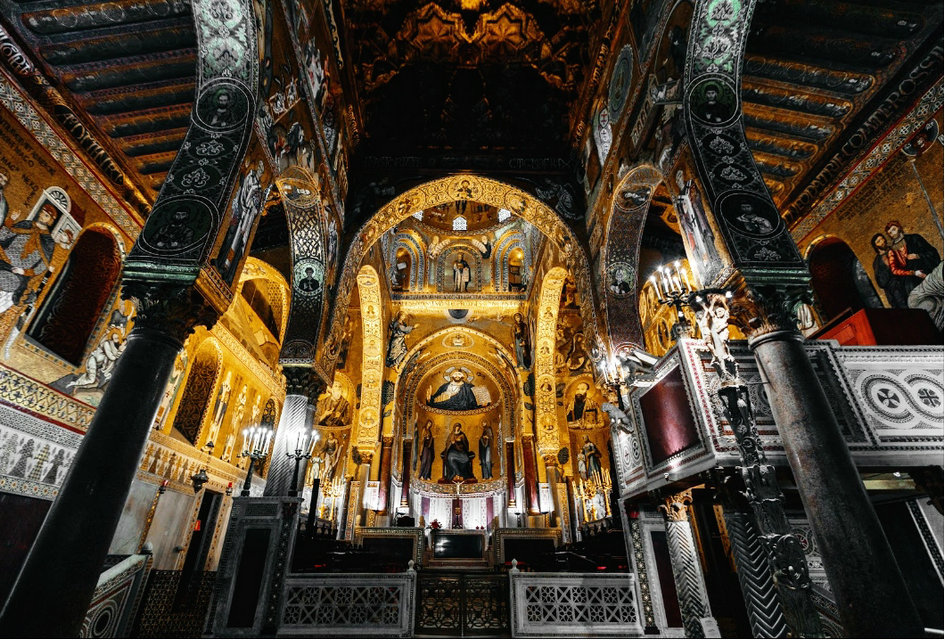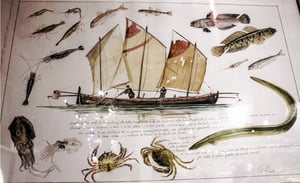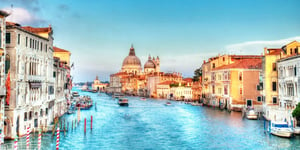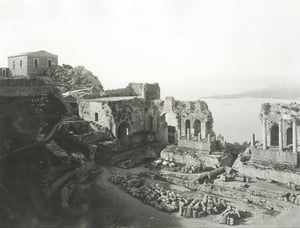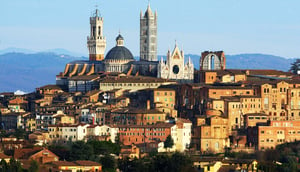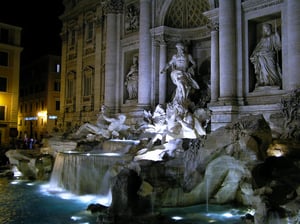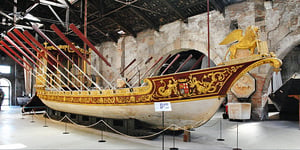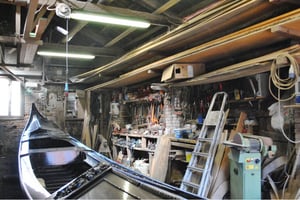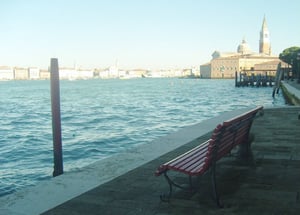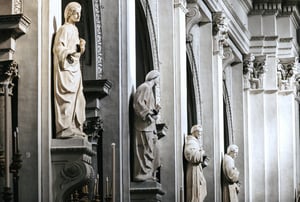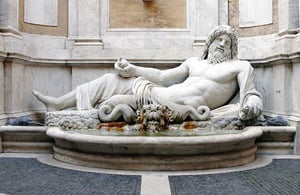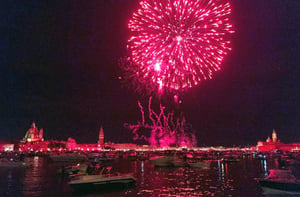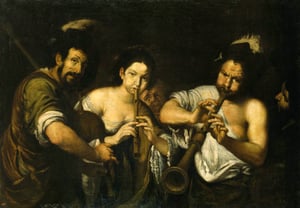The Arab-Norman architecture of Palermo style are magnificently enriched with carving and colored inlay, a curious combination of three styles — Norman-French, Byzantine and Arab.. They incorporated the best practices of Arab and Byzantine architecture into their own art.
Under the Normans, Sicily experienced a period of great artistic and cultural development, shown by the great works created in that period. The island became the seat of a true kingdom, with Palermo as its capital.
Known in Arabic as Madina al-Siquilliya, Sicilian city per excellence, the city of Palermo began as a Phoenician-Punic emporium. Passing through Roman, Vandal and then Ostrogoth domination, it first became Byzantine (535) and then Islamic (831-1071), known by the name Balàrm until the Norman conquest (1071-72).
The impact of a new culture of Nordic tradition on Sicily in the 11th-12th century led to a new architectural style: Palermo’s Arab-Norman architecture introduced innovative elements from the north of Europe, such as an accentuated verticality and the use of towers at the sides of façades, within Byzantine layouts, such as the Greek-cross plan inscribed in a square, and structural or decorative details of Islamic origin, such as pointed arches and beautiful polychrome inlays.
Between the first and the last decade of the 19th century, Palermo became an essential destination for travellers on the Grand Tour, who left evidence of their passing through the city in the drawings, letters and notes produced during their stay in Sicily. Medieval Sicily immediately attracted the interest of travellers from northern Europe, who arrived there with eyes filled with wonder.
Church of San Giovanni dei Lebbrosi
Founded by Robert Guiscard and his brother Roger of Hauteville upon the remains of the Saracen castle of Yahya (John, in Arabic), perhaps during the siege of Palermo in 1071.
In 1150, the church became a leper colony and the Swabian Frederick II transferred ownership of the church to the Order of the Teutonic Knights of the Magione, under whose control it remained until the 18th century. Some remnants of the Islamic era found near the church confirm the tradition associated with its foundation.
The interior has a basilica form divided into three naves by pillars with a wooden roof and domed sanctuary. The light filters through the single-light windows at the sides, which are slightly ogival in shape.
The building now stands in the centre of a palm garden where the remains of the previous Arab castle can still be seen.
At the centre of the dome there is a painted wooden crucifix from the fifteenth century.
Norman Palace
In ancient times, it was an Islamic castrum built upon previous structures of Punic origin, which are still visible in the basement levels. From 1072, it was the residence of the Norman kings and the imperial seat in the Swabian period. The castle was built on the highest point of the city for defensive purposes.
Its structure seems to have originally consisted of towers linked by wings, porticoes and gardens, of which only the so-called Torre Pisana still remains today. The Norman Palace remained the residence of the king until the end of the 14th century, when the Aragonese, who succeeded the Normans, decided for reasons of safety to transfer their residence to Palazzo Chiaramonte, known as “Palazzo Steri”. The complex thus became a fortress until the period of Spanish rule, when the Viceroy of Sicily took up residence there.
The arrangement of the piazza in front of the Norman Palace dates back to the second half of the 17th century. The “Teatro Marmoreo” (“Marble Theatre”), a sculptural group erected in 1662 in honour of Philip IV, stands in the centre of the piazza. Figures representing the parts of the world known at that time (Europe, Asia, Africa, America) are arranged around the pedestal, on which stands the statue by the sculptor Carlo d’Aprile.
The most important rooms of the Norman Palace are the Sala del Duca di Montalto, where exhibitions are regularly held, and the Sala Rossa and Sala Gialla, which are institutional headquarters. The Sala d’Ercole, so-named because its frescoes depicting Hercules, houses the meetings of the Sicilian Regional Assembly.
Cappella Palatina
The Cappella Palatina (1130) is located within the Norman Palace and was originally a private chapel for the king. It is one of the best preserved medieval monuments in Palermo: the opus sectile marble decoration on the floors, the Byzantine mosaics in the sanctuary and the nave, with episodes from the lives of the saints, the Gospel and the Bible, and the Islamic paintings on the wooden ceilings from 1143, characterised by Arab-style stalactites and honeycombs (muqarnas), have been preserved virtually unchanged.
The three-naved plan of the basilica is divided by pointed arches on columns and ancient re-used capitals. The proximity of the chapel to the building is emphasised by a balcony that allowed monarchs to attend religious functions directly from the apartments.
The Normans introduced mosaic art into the churches of Palermo, using some craftsmen from Constantinople.
The mosaic of Christ Pantocrator in the dome immediately captures the attention of visitors.
Church of San Giovanni degli Eremiti
The church was originally a pagan temple, then a Gregorian monastery, founded in 581 AD and dedicated to St. Hermes, and finally an Islamic place of worship in the 10th century. The church of San Giovanni degli Eremiti was built on its remains between 1130 and 1148.
The English writer Frances Minto Elliot writer describes San Giovanni degli Eremiti in her Diary of an Idle Woman in Sicily (1881): “A Norman church close to the palace and the Porta di Castro […] sheltered in a recess. It is entirely oriental and, with its five domes, would look perfect in Baghdad or Damascus. Next to it, the Gothic bell tower with four orders of porticoes is surmounted by another dome, a unique adaptation of Arab construction to a Christian custom.”
The site where San Giovanni degli Eremiti stands was considered a sacred place throughout the centuries and under various rulers as, according to tradition, a spring of water and an underground cave were found there. The plan of the Church has a single, tau-shaped nave with a single, protruding central apse. The exterior is arranged in accordance with the spacing of the hemispherical domes and the interconnection of the structural bodies, which are distributed on various elevation levels, following the natural topography of the terrain.
The cloister is defined by acute arches, supported by paired columns that become tetrastyle at the corners. The entire complex is now housed within a Romantic-style garden, created during the renovations of the nineteenth-century.
The plan of the Church has a single, tau-shaped nave, with a protruding central apse.
The red domes
At the end of the nineteenth century, the architect from Palermo Giuseppe Patricolo (1834-1905) organised various restoration works on the main Norman buildings of the city, with the aim of restoring the churches and palaces to their original medieval appearance. The red of the domes was his own invention, motivated by the discovery of traces of colour on the domes of San Giovanni degli Eremiti. This solution was replicated in the other Norman churches in Palermo and eventually came to symbolise them.
The Norman domes were coated in a waterproof plaster composed of lime and “crushed earthenware”, similar to that used in Roman buildings. This coating initially assumed a pink colour, which rapidly faded to an ashen grey due to the effect of the elements.
The church of San Cataldo
The church of San Cataldo stands on Piazza Bellini, in the heart of the city’s historical centre. The church was built during the reign of William I at the behest of Maio of Bari, Grand Admiral of the Norman king. The building, originally built as the private chapel of a palace that no longer exists, is based on a combination of simple structures: a parallelepiped core, interrupted on one side by the semi-cylindrical apse and surmounted by three red hemispherical domes on low windowed thoblates positioned above the central aisle.
The sandstone external façade has a compact wall surface, the severity of which is diminished by the incisions of the blind arches and the latticed recessed arches.
The internal plan has three naves, separated by columns with re-used capitals.
Santa Maria dell’Ammiraglio
The church of Santa Maria dell’Ammiraglio was founded by George of Antioch, a Byzantine and Grand Admiral of the Kingdom of Sicily at the service of Roger II. The Greek-Byzantine rite is celebrated there, brought to Sicily by Albanian refugees fleeing Turkish persecution in the Balkans, hence the name of the parish, San Nicolò dei Greci, as the Albanians were mistakenly referred to as “Greeks”.
For those trying to find this church, it should be noted that it is known to all simply as the Martorana, named after the nearby Benedictine monastery founded by the noblewoman Eloisa Martorana in 1194. An interesting fact: this is also name given to the famous marzipan fruits, a typical Palermo confectionary made from almond paste and eaten on All Souls Day, which were originally prepared by the Benedictine nuns.
The building combines Byzantine elements with others clearly of Islamic origin and has undergone several transformations and renovations over the course of its history, as can be understood from its current configuration.
The interior is decorated with splendid Byzantine mosaics, the oldest in Sicily. These were not only for decorative purposes, but also had a political and religious role: the Christ Pantocrator in the dome symbolises the Celestial Church with its court of angels.
At the centre of the dome is the blessing Christ enthroned, before whom four angels bow in adoration.
Eight classic figures of prophets are depicted in the octagonal tholobate with their right hands raised in the typical gesture of speaking and holding the scrolls of their prophecies in their left hands: David, Isaiah, Zechariah, Moses, Jeremiah, Elijah, Elisha and Daniel.
The decoration was executed by Byzantine craftsmen working in Sicily.
The cathedral
Its foundation dates back to Walter Ophamil, archbishop of the city from 1169 to 1190. It was initially the site of a fourth-century Basilica, destroyed by the Vandals, and a second construction built in the 6th century. Transformed into a mosque during the era of Arab domination, it was restored to Christian worship in the reign of William II. The cathedral was completely rebuilt after the earthquake of 1169 and consecrated in 1185; a covered walkway was built to connect it to the Royal Palace.
The portico forming the present-day entrance dates from around the mid-15th century and features three pointed arches. It is embellished by a spiral decoration representing the “Tree of Life”.
The interior and the dome were radically transformed in around 1767 by the architect Ferdinando Fuga, leaving the original Arab-Norman style preserved mainly in its façades. The statues placed on the pillars dividing the naves were originally part of a grandiose altarpiece by the sculptor Antonello Gagini (1478-1536), placed in the tribune and dismantled in 1797.
The Zisa
The Zisa, from the Arabic al-Aziz, the splendid, founded by King William I and completed by his son, stood outside the walls of the city and was the most important monument of the hunting park known as Genoardo (from the Arabic, Jannat al-ar, “garden” or “earthly paradise”) inspired by the riyads of Persian origin.
Outside, the large garden, originally annexed to the Genoardo, has been recently restored and reopened. The garden, divided in two by a water channel that reaches the Sala della Fontana, is traversed by some walkways and planted with typical Mediterranean plants.
The Sala della Fontana is the nerve centre of the entire building, decorated with mosaics and opus sectile marble inlays, niches with muqarnas vaulting and a rare Byzantine mosaic panel with secular themes and Islamic iconography. The hall was used by the sovereign to receive the court during the turbid Palermo summers.
Water flowed from the fountain in the wall down a marble slab and was conveyed along the channel along the centre of the hall to the fish pool in front of the building. The marble slab, in which the water from the fountain flows, is laid in an oblique position and decorated with chevrons.
The ceiling of the vault at the entrance to the Sala della Fontana is embellished with pictorial decorations depicting mythological figures. According to tradition, the images represent the so-called “Devils of Zisa”, which gave rise to several legends and popular beliefs.
Zisa now houses the Museum of Islamic Art, which preserves artefacts from the Maghreb area, including Musciarabia floors, wooden latticed screens, furniture and brass utensils decorated with engraving and inlays. A shaded pathway has recently been created, with a metallic structure that incorporates the geometric patterns of Islamic art.
The Cuba
The palace was built as a recreational pavilion for the Norman King William II. The King and his court rested in the Cuba during the hottest hours of the day, enjoying the coolness of the place, with its fountains, the view and the fruit from the trees surrounding the residence.
The building was part of the “Sollazzi Regi” circuit. The residence once stood at the centre of an artificial lake, which was drained at the end of the Norman dynasty, when the Cuba was converted into a hospital for plague victims.
The Cuba has a rectangular plan. The interior is divided into three communicating spaces. The remains of a marble fountain and some muqarnas decorations, typical of Islamic architecture, can still be seen at the centre of the main area.
Boccaccio uses the Cuba as the setting for one of the stories of the Decameron, describing the romance between Gianni di Procida and Restituta, who was kidnapped by Sicilian mercenaries in Ischia and given to Frederick, King of Sicily. After various adventures, the two lovers end up at the stake, but are saved by the king’s admiral, who recognises the youth as the nephew of a great commander instrumental in the political ascent of King Frederick.
Comitato Giovani della CNI Unesco – Regione Sicilia:
